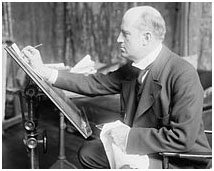Charles Dana Gibson
USINFO | 2014-06-20 09:53

Charles Dana Gibson (September 14, 1867 – December 23, 1944) was an American graphic artist, best known for his creation of the Gibson Girl, an iconic representation of the beautiful and independent American woman at the turn of the 20th century.
Gibson was born in Roxbury, Massachusetts, the son of Josephine Elizabeth (née Lovett) and Charles DeWolf Gibson. He was the great-grandson of U.S. Senator James DeWolf and the great-great-grandson of U.S. Senator William Bradford. A talented youth, he was enrolled by his parents in New York's Art Students League, where he studied for two years.
Peddling his pen-and-ink sketches, he sold his first work in 1886 to John Ames Mitchell's Life. His works appeared weekly in the magazine for over 30 years. He quickly built a wider reputation, his works appearing in all the major New York publications, Harper's Weekly, Scribners and Collier's. His illustrated books include the 1898 editions of Anthony Hope's The Prisoner of Zenda and its sequel Rupert of Hentzau. The development of the Gibson Girl from 1890 and her nationwide fame made Gibson respected and wealthy.
In 1895, he married Irene Langhorne, born in Danville, Virginia, a sister of Nancy Astor, the first woman to serve as a Member of Parliament in the British House of Commons. The elegant Langhorne sisters, born to a once-wealthy Virginia family devastated by the Civil War, served as the inspiration for the famous Gibson Girls.
He became the editor and eventual owner of Life after the death of Mitchell in 1918. The popularity of the Gibson Girl faded after World War I, and Gibson took to working with oils for his own pleasure. In 1918, he was elected into the National Academy of Design as an Associate member, and became a full Academician in 1932.
Share this page